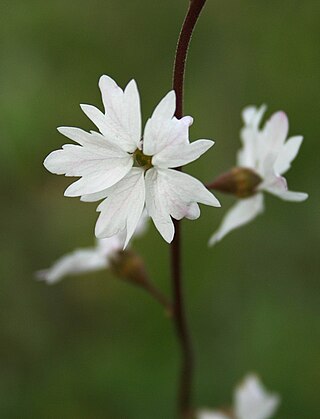
The Lamiaceae or Labiatae are a family of flowering plants commonly known as the mint, deadnettle or sage family. Many of the plants are aromatic in all parts and include widely used culinary herbs like basil, mint, rosemary, sage, savory, marjoram, oregano, hyssop, thyme, lavender, and perilla, as well as other medicinal herbs such as catnip, salvia, bee balm, wild dagga, and oriental motherwort. Some species are shrubs, trees, or, rarely, vines. Many members of the family are widely cultivated, not only for their aromatic qualities, but also their ease of cultivation, since they are readily propagated by stem cuttings. Besides those grown for their edible leaves, some are grown for decorative foliage. Others are grown for seed, such as Salvia hispanica (chia), or for their edible tubers, such as Plectranthus edulis, Plectranthus esculentus, Plectranthus rotundifolius, and Stachys affinis. Many are also grown ornamentally, notably coleus, Plectranthus, and many Salvia species and hybrids.

Mentha is a genus of plants in the family Lamiaceae. The exact distinction between species is unclear; it is estimated that 13 to 24 species exist. Hybridization occurs naturally where some species' ranges overlap. Many hybrids and cultivars are known.

Mimosa is a genus of about 600 species of herbs and shrubs, in the mimosoid clade of the legume family Fabaceae. Species are native to the Americas, from North Dakota to northern Argentina, and to eastern Africa as well as the Indian subcontinent and Indochina. The generic name is derived from the Greek word μῖμος (mimos), an "actor" or "mime", and the feminine suffix -osa, "resembling", suggesting its 'sensitive leaves' which seem to 'mimic conscious life'.

The International Plant Names Index (IPNI) describes itself as "a database of the names and associated basic bibliographical details of seed plants, ferns and lycophytes." Coverage of plant names is best at the rank of species and genus. It includes basic bibliographical details associated with the names. Its goals include eliminating the need for repeated reference to primary sources for basic bibliographic information about plant names.

Abutilon is a large genus of flowering plants in the mallow family, Malvaceae. It is distributed throughout the tropics and subtropics of the Americas, Africa, Asia, and Australia. General common names include Indian mallow and velvetleaf; ornamental varieties may be known as room maple, parlor maple, or flowering maple. The genus name is an 18th-century Neo-Latin word that came from the Arabic ’abū-ṭīlūn, the name given by Avicenna to this or a similar genus.

Edward Tuckerman was an American botanist and professor who made significant contributions to the study of lichens and other alpine plants. He was a founding member of the Natural History Society of Boston and most of his career was spent at Amherst College. He did the majority of his collecting on the slopes of Mount Washington in the White Mountains of New Hampshire. Tuckerman Ravine was named in his honor. The standard botanical author abbreviation Tuck. is applied to species he described.

Linaceae is a family of flowering plants. The family is cosmopolitan, and includes about 250 species in 14 genera, classified into two subfamilies: the Linoideae and Hugonioideae. Leaves of the Linaceae are always simple; arrangement varies from alternate to opposite or whorled. The hermaphroditic, actinomorphic flowers are pentameric or, very rarely, tetrameric.

Hesperocyparis arizonica, the Arizona cypress, is a North American species of tree in the cypress family Cupressaceae, native to the southwestern United States and Mexico. Populations may be scattered rather than in large, dense stands.

Hesperocyparis bakeri, previously known Cupressus bakeri, with the common names Baker cypress, Modoc cypress, or Siskiyou cypress, is a rare species of western cypress tree endemic to a small area across far northern California and extreme southwestern Oregon, in the western United States.

Polemonium, commonly called Jacob's ladders or Jacob's-ladders, is a genus of between 25 and 40 species of flowering plants in the family Polemoniaceae, native to cool temperate to arctic regions of the Northern Hemisphere. One species, Polemonium micranthum, also occurs in the southern Andes in South America. Many of the species grow at high altitudes, in mountainous areas. Most of the uncertainty in the number of species relates to those in Eurasia, many of which have been synonymized with Polemonium caeruleum.

Monardella is a genus of approximately 40 species of annual and perennial plants native to western North America from British Columbia to northwestern Mexico. They are grown for their highly aromatic foliage, which in some species is used for herbal teas. The two-lipped, tubular flowers are formed in terminal clusters and are most usually red, pink, or purple.

Microseris is a genus of plants in the tribe Cichorieae within the family Asteraceae, plants that often called composites. They are native to North America, South America, Australia, and New Zealand.

Samuel Frederick Gray was a British botanist, mycologist, and pharmacologist. He was the father of the zoologists John Edward Gray and George Robert Gray.

I. M. Johnston, was a United States botanist. He studied at Pomona College in Claremont, California and at Harvard University. His plant collections are housed in the Rancho Santa Ana Botanic Garden, in Claremont, and also in the Gray Herbarium of Harvard University.

Lithophragma is a genus of flowering plants in the saxifrage family containing about nine species native to western North America. These plants are known generally as woodland stars. The petals of the flowers are usually bright white with deep, long lobes or teeth. Each petal may look like three to five petals, when at closer inspection the lobes fuse into a single petal at its base. Most species reproduce via bulblets instead of seeds. L. maximum is a federally listed endangered species. Lithophragma specifically coevolved with moths of the genus Greya, who pollinate and only lay eggs on Lithophragma plants.

Tonella tenella is one of two herbaceous plant species in genus Tonella, which has been recently reclassified as a member of the family Plantaginaceae. This species is known by the common names lesser baby innocence and small-flowered tonella. The plant is a small annual herb with an erect stem up to 30 centimeters tall. The flowers are very tiny, only a few millimeters wide. The corolla is arranged with four petal lobes on one side and one larger petal lobe on the other. The lobed petals are white with blue or purple spots or streaks, and they surround four white stamens. Growing in the forest understory, often scrub oak, on moist rocky soil, its range extends from southern Vancouver Island, British Columbia to San Benito County, California.

Euphrosyne is a genus of flowering plants in the family Asteraceae.
XEAA-AM was a radio station on 1340 AM in Mexicali, Baja California. It was owned by Grupo Radio Centro

Nepetoideae is a subfamily of plants in the family Lamiaceae.

Hypericum gymnanthum, the small-flowered St. John's wort or clasping leaf St. John's wort, is a species of flowering plant in the St. John's wort family Hypericaceae native to wet woods, bogs, and ditches of the eastern United States and Guatemala. It has been introduced to Poland.



















